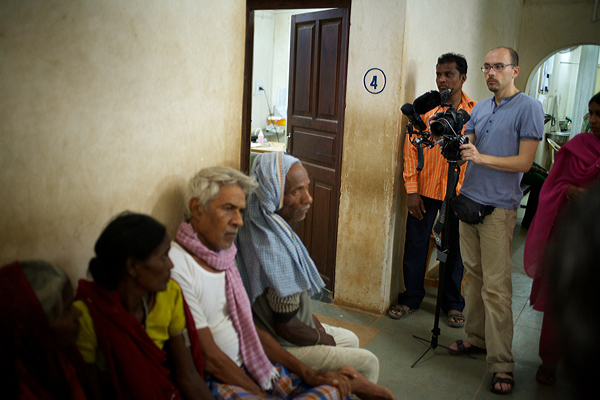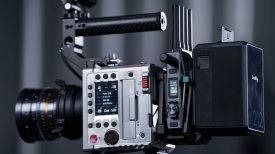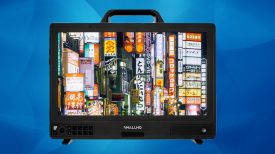By Tom Pietrasik
SALOON from Tom Pietrasik on Vimeo.
Before making Saloon – my first film – I had been aware of the potential of DSLRs to capture beautiful video, but uncertain of how exactly to approach this new medium. I’d been inspired to take things further by the work of Dan Chung, Philip Bloom and others I’d heard speak at the Canon Pro Solutions event last year in London. I took a video course organised by the National Union of Journalists and bought myself the basic kit required for film-making and began planning the production of a short film. I’ve learn t much from the process, not least of which is the basic – and often inconvenient – question of obtaining proper legal authorization for the use of music.
I chose my subject carefully. Having lived in Delhi for ten years, I was familiar with the relaxed and often jovial atmosphere of barber shops and knew that they were very colourful institutions that are great to photograph. The work of a barber also involves plenty of repetition, which is ideal for filming activity that can later be edited together to produce the sequences for a film.
I don’t like to interfere with subjects when I’m taking stills and I wanted to adhere to the same rule when making my film, to produce an authentic account of life in a barber shop. So I allowed events to unfold naturally and, apart from the early shots of the hairdressers looking to camera, the only scenes I “directed” were of a barber loading a blade into the razor and a hand collecting the comb (which I knew could be edited to one of the many shots I had of men grooming their newly coiffured locks).
‘Saloon’ was made over the course of a weekend in a lower-middle class suburb of New Delhi using my Canon 5DmkII and a Chrosziel focus-finder mounted on a Manfrotto 679B monopod with the optional retractable legs that provide for greater stability. I’ve always used prime lenses for my stills work but was aware that a zoom would allow me to work faster, mixing wider establishing shots and close-ups without the need to change lenses. So, I opted for a Canon 24-70mm f2.8L as my principal lens.

This set-up is not perfect. I found that the cramped confines of a barber shop are not particularly suited to working with a monopod and, for a few of the shots in Saloon, I worked hand-held, dispensing with the focus-finder and resorting to my lighter Canon 50mm f1.4 lens instead of the zoom lens. In addition to providing a few extra stops, this smaller kit allowed me to get close-in to my subjects without the awkwardness of wielding a large lens.
The music for Saloon was an important decision. I’ve never particularly enjoyed Indian commercial cinema but, ever since I saw the movie Dil Se, almost 15 years ago, I’ve been aware that the Tamil composer A.R. Rahman has written some wonderful musical scores. Not only is “Satrangi Re” an infectious song, it comprises a couple of distinct themes and breaks between these themes which is great for editing. As the song ebbs and flows, so too do the sequences of my film and, though it’s less than three minutes long, I like to think that the shifting pace – accentuated by Rahman’s score – somehow makes Saloon feel more substantial.
I made Saloon mainly practice my skills and it was only later, buoyed by the praise I’d received from the small number of friends to whom I’d subsequently shown the film, that I considered entering Saloon into competitions and festivals. The prospect that my film might be widely screened by established institutions meant I had no alternative but to obtain a music license for Satrangi Re. I began negotiation from an awkward position. Satrangi Re had become such an integral part of Saloon that I couldn’t envisage an alternative. I just didn’t want to contemplate the idea of my film running to a different soundtrack. Not only would this involve a lot of time and effort re-editing, but the result was likely to be less effective without the oscillating rhythm that seemed so well suited to Saloon.
I also had the niggling anxiety that I might actually be refused a licence or that the rights holder would quote me a fee beyond my means. I had no idea what I was getting into. Rahman had relinquished ownership of Satrangi Re many years ago and I would have to deal with a Mumbai-based production company with vastly more experience in the negotiation of music rights than me. Ultimately, the process proved quite difficult. There was lots of back and forth on the phone and I found the experience not unlike attempting to agree a taxi fare with the many drivers I’d employed during my ten years work as a photographer in India.
To my relief a licence was eventually granted which means my film can now be shown – along with other shortlisted Virgin Media Shorts – as a preview to features screened at Picturehouse cinemas across the UK over the next twelve months. It’s a real privilege to have AR Rahman’s music feature in my short film but the process of establishing the right to use his work is not one I’d like to repeat. It really is worthwhile anticipating the question of legal permission for the use of music well before the editing process begins.
Saloon has now been entered into several festivals and it has been shortlisted for this year’s Virgin Media Shorts competition (a winner will be announced on November 10th).
Tom Pietrasik is a British photographer & filmaker dividing his time between London and New Delhi. His photography has appeared in a variety of publications including National Geographic Adventure magazine, The Financial Times magazine and Marie Claire. He also shoots for development agencies including UNICEF and the World Health Organization together with NGOs like ActionAid, Oxfam and Save the Children. You can read more about Tom on his blog.






